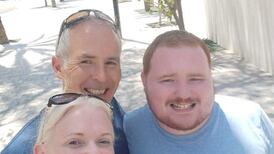Time was when waxing and waning moons governed food sowing and growing and many farmhouses had a lunar calendar hanging from a kitchen wall. Yet when Cáit Curran left a southwest Kerry hill farm to pursue a career in the Civil Service in Dublin, little did she know that the lunar movements would become such a big part of her life.
“When you start telling people in detail, they do think you are out of your mind,” she chuckles, describing how she came to be one of Ireland’s first certified biodynamic farmers. “But when you look at how the moon has such an influence on our tides, it only seems to make sense that it would also affect the soil.”
Curran, who is best known as a seller of organic fruit and vegetables in the weekly Galway market outside St Nicholas's Collegiate Church, became interested in the biodynamic farming concept when running a restaurant in Clonmel, Co Tipperary.
“I had spent 13 years in the Civil Service and had quit Dublin at that stage. The restaurant was a co-operative,”she adds. “One of our vegetable suppliers used the biodynamic method of growing and his produce really stood out from the rest.”
A local group interested in the work of late 19th-century Austrian philosopher and mystic Rudolf Steiner also met regularly in the restaurant and Curran would hear the chat. Steiner had formulated a type of science which he called anthroposophy, combining the Greek words for human (anthropos) and wisdom (sophia). "Some of it was quite heavy going, but Steiner's theories on biodynamic growing were often discussed," Curran says.
She knew a fair bit about self-sufficient farming from her childhood days in Kerry, but had enough curiosity to read up a bit more. However, it was just an idea for a time – although one that she packed up and carried with her when she moved north to Co Galway 25 years ago. “I did a one-year course in organic farming under the New Opportunities for Women programme, funded by the EU, and the best way to learn was to start planting,” she says.
She began growing vegetables organically, initially in Athenry and latterly in a walled garden at Castlehackett. She took a stall in the Galway market to sell her own produce, supplementing it with organic fruit from abroad and some vegetables supplied by her sister, who grows grain and keeps sheep in Co Offaly. She became involved in training community groups in Connemara and helped to set up Galway city’s first community garden, in Ballybane.
Four years ago, she bought her own two-acre holding with a disused cottage in Loughwell, near Moycullen – a wide, high and windy location surrounded by bog, and now a few wind turbines. It seemed the right time to test those biodynamic techniques she had heard about so many years before.
“There were good practical reasons – the soil is so poor here that it requires lots of manure and seaweed,” she explains. “And I was becoming a bit disillusioned with the way conventional agricultural advice was beginning to influence the organic movement – with little shortcuts creeping in here and there.”
As she had read all those years before, Steiner believed that the moon, stars and planets had an influence – along with weather and climate – on the quality of soil. His theories were developed at a practical level by German farmer Maria Thun, who ran a series of controlled trials with her radish crops in the 1950s. Thun was convinced that the moon's movement through constellations had an impact on plants.
Root crops, including onions and leeks, did best if sown when the moon was passing through constellations associated with the earth element. Leafy crops thrived when the moon was associated with water signs, while fruit did best with fire signs and flowering plants did best with air signs, she claimed.
In the early 1960s, Thun began publishing annual calendars, indicating the flower, root, leaf and fruit days. She also advised on natural nutrients to improve composting, including nettle, yarrow, chamomile, dandelion, valerian and horn silica, a type of ground quartz, Curran says.
Thun, who died in 2012 at the age of 89, also applied her theories to wine. She was author with her son Matthias of When Wine Tastes Best: A Biodynamic Calendar For Wine Drinkers, published in 2010.
Curran finds that European visitors to the Galway market are familiar with the concept and tend to recognise her certification, approved by the British biodynamic association, immediately.
“Perhaps it is because their countries have experienced far more environmental degradation and pollution, but they do think far more about the quality of their food and less about the cost,”she says. “Given how our health depends on it, that sort of focus does seem to make sense.”
Cáit Curran is giving a free talk, entitled Beyond Organic, as part of the Living Cities series at Loam restaurant and wine bar, Geata na Cathrach (near the Coach Station on Fairgreen Road, Galway), tomorrow at 5pm.










